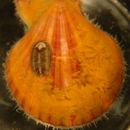Habitat
provided by Invertebrates of the Salish Sea
Common intertidally under rocks, both on outer coast and in bays.
- license
- cc-by-nc-sa
- copyright
- Rosario Beach Marine Laboratory
Distribution
provided by Invertebrates of the Salish Sea
Geographical Range: SE Alaska to Ventura, CA. This species is said to be very common in California but is not often mentioned in guides to the Pacific Northwest.
- license
- cc-by-nc-sa
- copyright
- Rosario Beach Marine Laboratory
Comprehensive Description
provided by Invertebrates of the Salish Sea
This chiton has a girdle with sparse but easily seen dorsal, slender, flexible hairs which are not as long as the girdle is wide. The branches of the hairs, if present, come only from the proximal parts of the larger hairs. There are no large granules on the dorsal surface of the girdle. There is a pronounced cleft in the posterior end of the girdle. The ventral surface of the girdle is not orange. Plates 2-7 have rows of tubercles. The lateral regions of plates 2-7 are separated from the central area by a slight, nearly smooth ridge or a series of slightly enlarged tubercles but not by a large ridge or a series of enlarged, coalesced tubercles. May have very light blue lines on plates and the interior of the plates are white. Length up to 10 cm.
- license
- cc-by-nc-sa
- copyright
- Rosario Beach Marine Laboratory
Look Alikes
provided by Invertebrates of the Salish Sea
How to Distinguish from Similar Species: Mopalia muscosa has dense, straplike hairs on the girdle. Mopalia lignosa has more hairs on the girdle and has no obvious rows of raised tubercles on the plates, plus the posterior cleft in the girdle is absent or very small and the ventral girdle is orange. Neither M. muscosa nor M. lignosa has a prominent posterior cleft in the girdle. Mopalia ciliata does have a prominent posterior girdle cleft but its girdle hairs are strap-shaped, have glassy spicules, and branch other than at the base.
- license
- cc-by-nc-sa
- copyright
- Rosario Beach Marine Laboratory
Comprehensive Description
provided by Invertebrates of the Salish Sea
Biology/Natural History: This species feeds on filamentous algae, diatoms, polychaetes, amphipods, and barnacles. It is common on shaded pilings, where the valves are often overgrown by bryozoans, annelids, barnacles, and hydroids. The reproductive cycle is variable but in California it is mainly from October to March. It does not brood its young. It may have the flatwormNexilis epichitonius symbiotic in its mantle cavity.
- license
- cc-by-nc-sa
- copyright
- Rosario Beach Marine Laboratory
Habitat
provided by Invertebrates of the Salish Sea
Depth Range: Intertidal
- license
- cc-by-nc-sa
- copyright
- Rosario Beach Marine Laboratory
Mopalia hindsii
provided by wikipedia EN
Mopalia hindsii is a species of medium-sized chiton that grows up to 7 cm long. Most commonly found in intertidal zones, M. hindsii has a white ventral side unlike most intertidal chitons that are orange underneath.
Range
Mopalia hindsii have been observed from South California north to Alaska.
Habitat
Mopalia hindsii are most common in protected environments like shallow bays, underneath rocks and on shaded pilings.
Diet
While most chitons are herbivores, M. hindsii will graze on just about anything in its path that doesn’t escape including polychaetes, amphipods, barnacles, sponges and algae. This uncommon lifestyle most likely explains why M. hindsii are able to survive in areas too silty for other chitons.
References
- Kozloff, Eugene N. Marine Invertebrates of the Pacific Northwest. Seattle, WA: University of Washington Press, 1996.
- Lamb, Andy, and Hanby, Bernard P. Marine Life of the Pacific Northwest. Madeira Park, BC: Harbour Publishing, 2005.
- Kozloff, Eugene N. Seashore Life of the Northern Pacific Coast. Seattle, WA: University of Washington Press, 1973.

- license
- cc-by-sa-3.0
- copyright
- Wikipedia authors and editors
Mopalia hindsii: Brief Summary
provided by wikipedia EN
Mopalia hindsii is a species of medium-sized chiton that grows up to 7 cm long. Most commonly found in intertidal zones, M. hindsii has a white ventral side unlike most intertidal chitons that are orange underneath.
- license
- cc-by-sa-3.0
- copyright
- Wikipedia authors and editors

